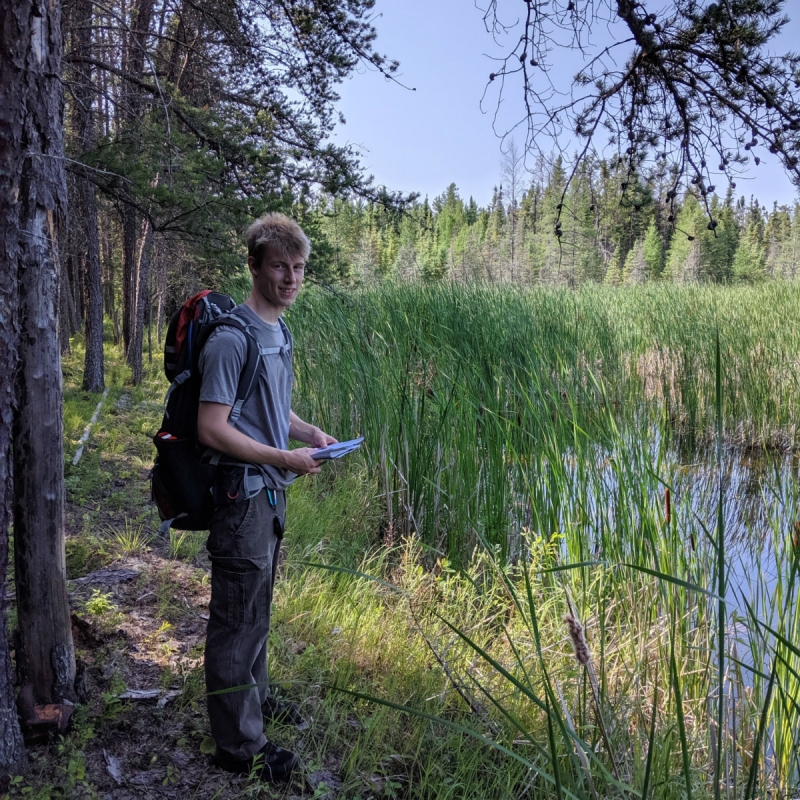
Something worth protecting: a practicum story
"I got to see my love for working with kids meet my love of nerdy things (like spreadsheets) in the pursuit of ecological conservation."
Graham Peters is completing his fourth and final year of a Bachelor of Arts in Environmental Studies. He arrived on campus in the first year of CMU's expanded Biology program and, though he was not yet sure what he wanted to do, he quickly began to rediscover and expand his love of ecology. This led to a major in Environmental Studies, and a practicum focused on conservation ecology.
"I've always cared about the environment and been fascinated by living things. I guess I took ecology because I wanted to put my love of nature towards something productive, like conservation. I want to help protect what I love," Peters says.
Peters completed his practicum requirement this past summer, through two six-week placements: first, at FortWhyte Alive, just 10 minutes south of the CMU campus, and second at A Rocha Manitoba in East Braintree, an hour and a half outside of Winnipeg, near Whiteshell Provincial Park.
"These experiences gave me a lot to consider about how I could practice conservation ecology in the future. I took on a wide variety of tasks related to different parts of the job—from education, to data collection and entry, to field observation—learning new skills and personal lessons along the way."
Peters' FortWhyte placement involved a combination of pure research, and outreach or interpretation. There, he dedicated much of his time to working with children and students, ranging in age from four to 17.
"Although taking a group of students on a walk through the wilderness may not seem like a critically important part of conservation, my time at FortWhyte showed me exactly the opposite. As I led school groups through grasslands, wetlands, and forests, teaching them about everything from the importance of maintaining biodiversity to the characteristics of different water bodies, I came to realize that this work was about getting children invested in caring for the environment. By wading through the water looking for invertebrates or wandering through the woods identifying plant species, we can use education to get the next generation invested in conservation. We can show them that the natural world is exciting, and something worth protecting."
"Moving from teaching to applied research, I got to take students out to different rivers around Winnipeg and teach students how to do a baseline survey on a river, measuring its dimensions, chemical content, velocity, etc. Afterwards, I would test the water using chemical kits to verify the students' recorded values, then take that data and put it into spreadsheets, comparing measures over time in order to monitor the health of these rivers. Basically, I got to see my love for working with kids meet my love of nerdy things in the pursuit of conservation."
Peters' second placement brought him to A Rocha Manitoba, where a previously forgotten series of interpretive trails is being reclaimed for active use.

"My job was to clarify where exactly the trails were and make recommendations for development. More than that, I was to identify areas of special educational value, such as changes in ecozones or signs of wildlife. I walked the trails many, many times, and became very familiar with my surroundings—though not without getting lost once or twice. As I walked, I would stop and look, and I have learned that when you take the time to do this, you will find yourself noticing how much there really is to look at."
Peters says he looks forward to honing the new tools this practicum has given him, as he continues to discern a specific career path:
"I believe that practical application of the skills and knowledge I have amassed during practicum will help me practice conservation in way that will utilize my strengths, and help my overcome my weaknesses. Moreover, these placements gave me a new understanding of how the whole earth really is filled with the glory of God. From falcons that circled overhead to the cedar trees that offered a brief reprieve from mosquitoes, God created all that I witnessed in nature, and all of it is beautiful and meaningful."
To learn more about CMU's practicum options, or the Environmental Studies program, visit our website—or contact an admissions counsellor.
Printed from: media.cmu.ca/story-grahampeterspracticum
